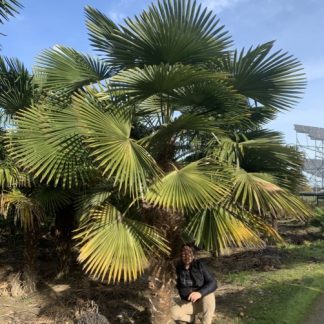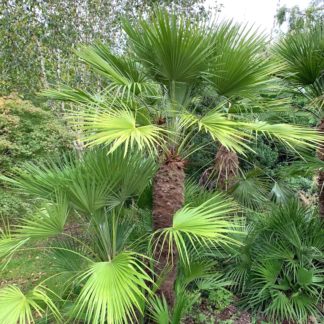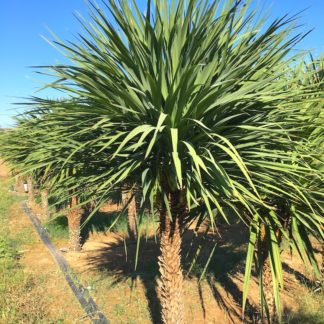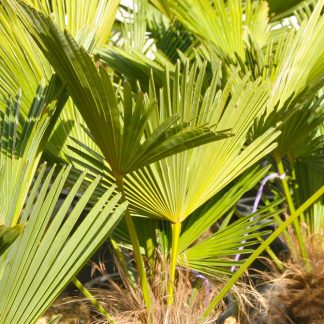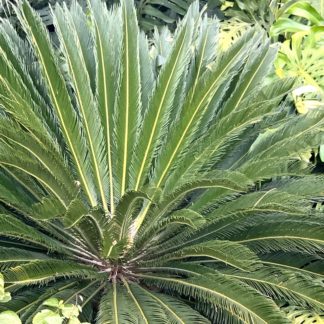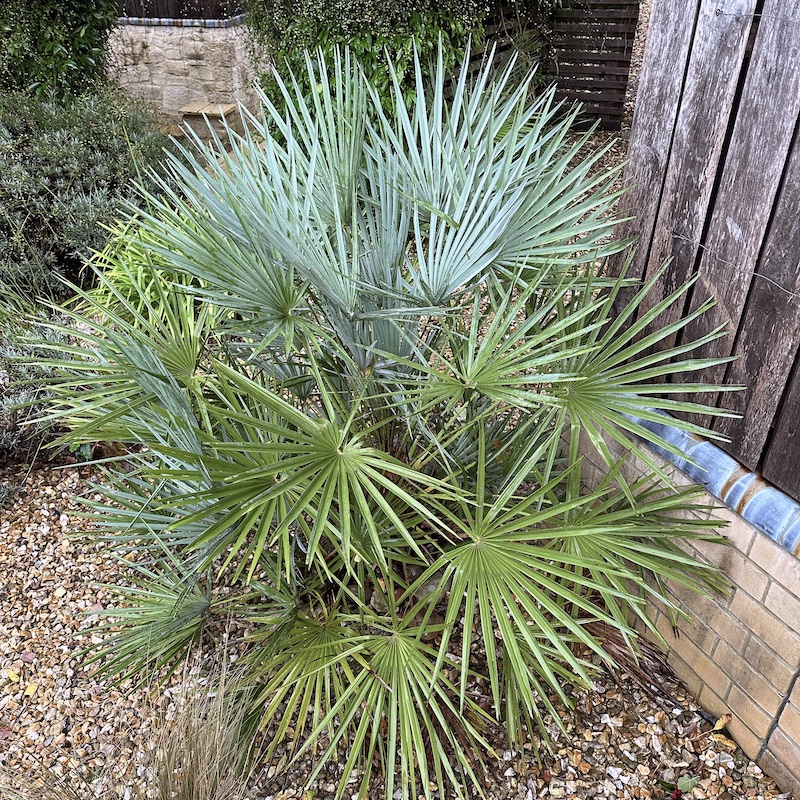Big Plant Nursery Guide to Choosing a Hardy Palm
Palms for the UK Garden
Many of us like palms and want to grow hardy palms in our garden. Unfortunately the list of hardy palms suitable for UK gardens is fairly small. It’s also best to buy the largest palm you can afford for increased hardiness and effect, so choosing the right hardy palm is important to make the best purchase. At Big Plant Nursery we have been trialling, growing hardy exotics, hardy and not so hardy palms for over 20 years in our hot in summer but chilly in winter (frost pocket) West Sussex growing site. I’m fairly confident that if you follow our advice you won’t go far wrong. Just bear in mind it’s all about micro-climates and using the warmest part of your garden to best advantage.
We’ll start with hardy palms that have a realistic chance of not just surviving but growing into magnificent palms.
Trachycarpus fortunei, Chusan Palm or Windmill Palm
By far the easiest hardy palm growing in most parts of the UK. Trachycarpus fortunei occurs naturally in Northern China where it grows on wooded hill sides able to cope with sun and shade whilst being tolerant of heavy rain and damp soils – Perfect for the UK! Trachycarpus fortunei have big palmate leaves and a hairy fibrous trunk they are head and shoulders above all other hardy palms for growing here in the UK if you want to try a palm this is the one! Amazingly tolerant of most conditions and able to grow quite fast I think every garden should have one (or two) just bear in mind that with such big impressive leaves choose a spot where your chusan will get a little shelter from strong winds… It will grow in exposed positions but always looks better with a little shelter – Invest in one now!! We grow Chusan Palms in our heavy wet (in winter) and dry (summer!) clay. They positively flourish growing as much as 30cm of trunk a year whilst looking magnificent. People often ask ‘I’ve got a chusan palm what should I plant next?’ my reply is always ‘plant another!’ It should be noted that there are at least nine other species of Trachycarpus in the world along with several different cultivars. One that we consider pretty tough alongside fortunei as a good hardy palm is ‘Wagnerianus’ yes a silly name but a good palm! Waggy’s as they are often known are sometimes described as dwarf trachycarpus, not really the case as the trunks get pretty tall, over 3m but the leaves are smaller and stiffer on stout stems, I like the look of these palms when they are young though they tend to look a little less stunning as they mature. Trachycarpus wagnerianus is a better choice if it’s a bit windy for fortunei.
Another is Trachycarpus takil with large deep green leaves and eventually slender trunk free from the fibre seen on fortunei.
In my opinion if you really want to collect different Trachycarpus species that’s fine but Trachycarpus fortunei itself is very variable, have a look at a crop of young palms and you will see lots of variation in both colour and leaf structure so my advice is choose a fortunei you like the look of and be happy its going to grow well, be hardy and look spectacular for many years.
Chamaerops humilis (Mediterranean Fan Palm)
Chamaerops are tough bushy palms originally the only true palms found in the Mediterranean mainly originating from the Island of Crete. Chamearops cope with full sun, a little shade and are fairly tolerant of windy sites making them great candidates for coastal planting, roof gardens and terraces. In our garden they just about cope with the heavy clay here growing well in the 12 years they’ve been planted. During cold winters, combined with heavy snow the foliage can be damaged but recovery is fairly fast during the summer. For that reason if the forecast is bad and snow is forecast I tend to cover the crowns with fleece. So I’d say best in milder parts of the UK, excellent in urban areas and coastal zones.
There are a few different forms of Chamaerops humilis available such as Chamaerops humilis ‘Cerifera’ or ‘Argentea’ as it’s sometimes called. Originating from the high Atlas Mountains in Morocco Chamaerops humilis ‘Cerifera’ is a dwarf form with superb bluish grey leaves, which I consider to be even hardier than the species. Another is the stunning Chamaerops humilis ‘Vulcano’ discovered growing on the slopes of Mount Etna in Sicily with really stiff congested leaves, a mature specimen of ‘Vulcano’ is spectacular. I’d say from experience that Chamaerops humilis ‘Vulcano’ is slightly less hardy.
Jubaea chilensis (Chilean Wine Palm)
What can I say? This is my favourite ‘Feather Palm’ with true long pinnate leaves just like the exotic palms you see in Barbados. However Jubea also known as Chilean Wine Palm is as its name suggests from Chile where it copes well with hot summers and cool winters.
The trunk can reach 2 or more metres in diameter and is full of sweet sap that the locals in Chile tap and ferment into wine!
In the UK, well here at Big Plant, my Jubea has been planted for over 12 years looking wonderful albeit growing very slowly – yes this one is best bought as big as possible (Sorry it will be expensive!) However it does look lovely with deep green foliage and stout appearance. Mine has survived some really cold spells down to at least minus 14C but I still panic when snow is forecast and cover it to keep the worst of the weather off the leaves. I’d say this palm is essential if you love palms and well worth planting.
Phoenix canariensis
A very tempting palm, Phoenix canariensis or Canary Island date palm, Pineapple palm is widely available and often very inexpensive. In warm climates Phoenix canariensis grows fast forming a tall showy specimen in just a few years making it popular with growers and consumers alike. We’ve all seen them growing in Mediterranean towns forming large beautiful palms, indeed in mild parts of the UK there are also some superb specimens. However bare in mind that canariensis really doesn’t like much frost – let alone snow. No matter how hard I try they will not survive planted out at Big Plant Nursery. It really needs to be in a warm garden ideally in areas with Gulf Stream influence or planted in protected urban areas. There are some large specimens growing happily in and around London for instance.
So if you have the right location give it a go, just allow enough space and watch out for the sharp spines at the base of each leaf.
Butia capitata
Yet another great palm, which is proving surprisingly hardy. Originally from Chile and Argentina the Jelly Palm is like the Jubea, a feather palm producing beautiful arching greyish green leaves held on a stout stem. We’ve grown Butia’s for many years and have found that as long as you give them reasonable drainage they are pretty tough surviving the worst of weather here at Big Plant, quite slow growing, hence not the cheapest but definitely worth a go and a great contrast to Jubea which have stiffer and darker green leaves.
The name Jelly Palm originates from the jelly or jam that can be made from the ripe fruits produced in late summer. I can vouch for one of our customers in Worthing who makes this most years and very tasty it is too!
Butia capitata also has a cousin Butia eriospatha that is similar but greener and more arching. We’ve found that it seems just as hardy and easy to grow.
Washingtonia robusta
Washingtonia are big showy palms with large palmate leaves originally from the southern states of USA and Mexico. They grow in hot arid regions and have long fleshy roots that tap into ground water.
In the UK they are not terribly hardy, definitely not one I can grow here at Big Plant Nursery but surprisingly if you live near the coast or in a warm micro-climate Washingtonia can and will do very well. Often damaged by cold weather even in mild locations the redeeming factor with Washingtonia is that it can grow really fast replacing many damaged leaves in one summer. There are some great specimens I’ve seen in London, Brighton, Isle of Wight and of course the West Country.
Despite coming from hot arid locations it’s important to give them lots of water and feed during the growing season. Another plus point for Washingtonia palms is that they seem quite happy to be wrapped up for winter with fleece or hessian, a protection so worth experimenting with.
Its worth noting that there are two species generally available – Washingtonia robusta and Washingtonia filifera. Both should be treated the same but I think that many sold are probably hybrids of the two and hard to tell apart when young.
Brahea armata (Mexican Blue Palm)
As its name suggests Brahea armata is from Mexico growing in hot arid areas usually near water holes or underground springs.
Unfortunately Brahea armata won’t tolerate my wet clay so I’ve given up trying which is a shame because it’s a stunning palm with large greyish blue palmate leaves held on a stout trunk.
Again like Phoenix canariensis I know of Mexican blue palms growing well in London, Brighton along the coast and in the South West. So worth a try if you have a mild location and are patient or prepared to invest in a larger specimen as Brahea are slow but steady growers.
Here’s a few more that are pretty tough but unless they get hot summers with constant temperatures above 23C these palms will either very slowly grow or may even start to shrink each year. So unless you really want to collect palms best leave these to the enthusiasts.
Phoenix theophrasti – The Cretan date palm
As its name suggests from Crete, this palm has very stiff spiky leaves in form eventually forming a clump of impressive foliage
Rhapidophyllum hystrix – Needle Palm
From the southeastern USA growing in swampy locations the needle palm forms dense clumps of spikey palmate deep green leaves.
Sabal minor – Dwarf palmetto
A showy palm with large palmate leaves from southern USA. I’ve had sabals last a few years only to slowly shrink in size each year as they survive but fail to produce new leaves. Hot mild garden only please.
Trithinax campestris – Blue needle palm, caranday palm
Trithinax campestris are super palms from Argentina with stout spiky trunks topped with really stiff and sharp blue grey leaves. I’ve had a large specimen planted for 10 years, which grew well for 7 years surviving some really cold winters. The last 3 years however it’s not really grown and is looking sad. I think its roots are down into the clay and it doesn’t like it.
There are some in gardens near the coast and in sandy soil where I’ve seen it doing well so worth a try, just painfully slow and painful if you brush against a leaf too!
Now near the end bit some of you will be wondering why I haven’t listed the Torbay Palm, Cordyline australis. Probably the most common and often seen ‘Palm’ in the UK. Well that’s because Cordylines are in fact more closely related to lily’s than palms so really shouldn’t be in a palm guide. But they look so good, are easy and fast to grow we might as well mention that cordylines are essential to palmy-type planting and are tolerant of wind and coastal conditions and not too fussy about soil. Just bear in mind that cordylines can be damaged in cold winters (they usually recover) and in cold inland gardens they benefit from winter protection.
So that’s pretty much our experience of growing palms over the last 20 years I hope you find it useful but as ever if you have any questions either email or call the nursery.
Super quick guide in a nut (palm) shell
Trachycarpus fortunei + Wagnerianus – Sun or shade any soil, avoid exposed windy sites as leaves get damaged. Wagnerianus is slightly more tolerant of wind.
Chamaerops humilis – Sun / part-shade, most soils except water logged, great in a container, tolerant of wind and coastal conditions.
Phoenix canariensis – Sun, mild garden or coastal (South of England), most soils, will need protection in cold winters, tolerant of wind.
Jubaea chilensis – Sun / part-shade, most soils, hardy feather palm but very slow growing, protect when young.
Butia capitata – Sun / part-shade, most mild gardens, slow growing feather palm, protect when young, grey green arching leaves.
Washingtonia robusta – Sun, best in very mild or coastal garden, fast growing, can be wrapped in winter.
Brahea armata – Sun, free draining soil, slow growing, needs a very mild hot garden, best planted so not suitable for long term container growing.
For any further information about your Hardy Palm Trees, please either call us on 01903 891466 or email us at info@bigplantnursery.co.uk and we will be glad to help.

